

Compact Muon Solenoid
LHC, CERN
| CMS-HIG-18-015 ; CERN-EP-2019-277 | ||
| Search for charged Higgs bosons decaying into a top and a bottom quark in the all-jet final state of pp collisions at $\sqrt{s}=$ 13 TeV | ||
| CMS Collaboration | ||
| 21 January 2020 | ||
| JHEP 07 (2020) 126 | ||
| Abstract: A search for charged Higgs bosons ($\mathrm{H}^\pm$) decaying into a top and a bottom quark in the all-jet final states is presented. The analysis uses LHC proton-proton collision data recorded with the CMS detector in 2016 at $\sqrt{s} = $ 13 TeV, corresponding to an integrated luminosity of 35.9 fb$^{-1}$. No significant excess is observed above the expected background. Model-independent upper limits at 95% confidence level are set on the product of the $\mathrm{H}^\pm$ production cross section and branching fraction in two scenarios. For production in association with a top quark, limits of 21.3 to 0.007 pb are obtained for $\mathrm{H}^\pm$ masses in the range of 0.2 to 3 TeV. Combining this with data from a search in leptonic final states results in improved limits of 9.25 to 0.005 pb. The complementary $s$-channel production of an $\mathrm{H}^\pm$ is investigated in the mass range of 0.8 to 3 TeV and the corresponding upper limits are 4.5 to 0.023 pb. These results are interpreted using different minimal supersymmetric extensions of the standard model. | ||
| Links: e-print arXiv:2001.07763 [hep-ex] (PDF) ; CDS record ; inSPIRE record ; HepData record ; CADI line (restricted) ; | ||
| Figures | |

png pdf |
Figure 1:
The LO diagrams for production of a heavy charged Higgs boson, showing the production with a top and bottom quark (4FS) (left) and via an $s$-channel process (right). |
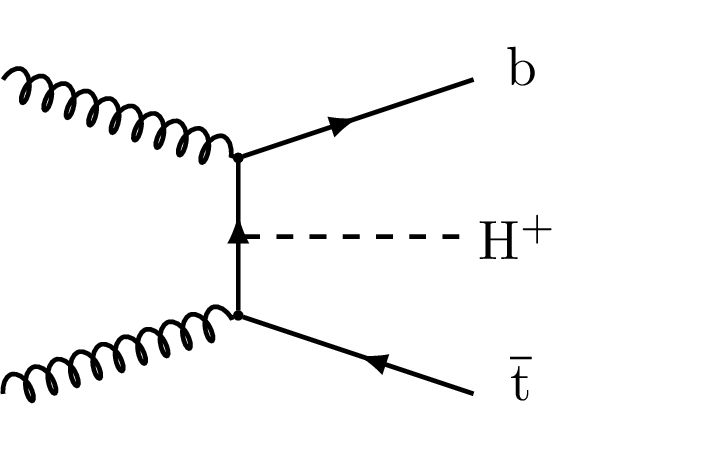
png pdf |
Figure 1-a:
The LO diagrams for production of a heavy charged Higgs boson, showing the production with a top and bottom quark (4FS) (left) and via an $s$-channel process (right). |
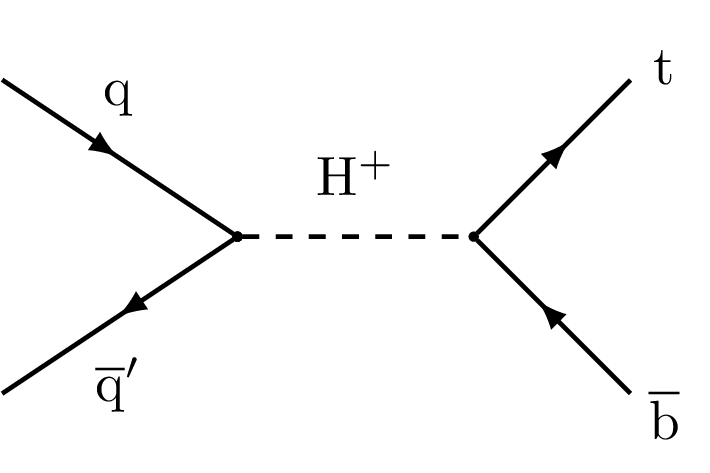
png pdf |
Figure 1-b:
The LO diagrams for production of a heavy charged Higgs boson, showing the production with a top and bottom quark (4FS) (left) and via an $s$-channel process (right). |

png pdf |
Figure 2:
Data and SM background for the event sample with one t jet as a function of the charged Higgs boson candidate mass. The category t1b is shown and the background normalization is fixed to the SM expectation. The signal mass distributions for associated and $s$-channel production of an ${\mathrm{\tilde{H}^{\pm_j}}}$ with $ {m_{\mathrm{H} ^\pm}} = $ 1 TeV normalized with a cross section times branching fraction of 1 pb are superimposed as open histograms. The signal mass window "in'' for associated production is shown together with the sidebands "below'' and "above'' for the mass hypothesis of 1 TeV. |
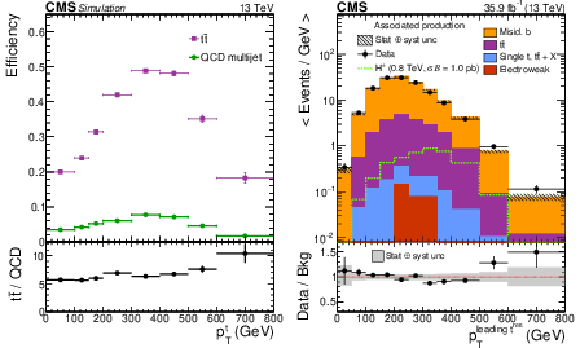
png pdf |
Figure 3:
The efficiency of the $ {\mathrm{t} ^\text {res}} $ selection in simulated ${\mathrm{t} {}\mathrm{\bar{t}}}$ pairs and the misidentification rate for QCD multijet background, as a function of top quark or top quark candidate ${p_{\mathrm {T}}}$, respectively (left). The ${p_{\mathrm {T}}}$ distribution of the leading ${\mathrm{t} ^\text {res}}$ (right) for the signal model and background with normalization fixed to the SM expectation. The dominant background containing misidentified b-jets is primarily composed of QCD multijet processes. The expectation for a signal with $ {m_{\mathrm{H} ^\pm}} = $ 0.8 TeV is also shown. |
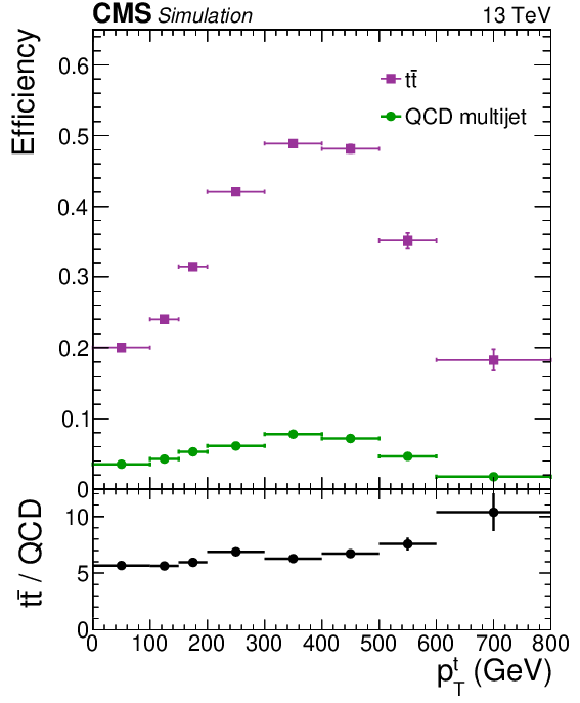
png pdf |
Figure 3-a:
The efficiency of the $ {\mathrm{t} ^\text {res}} $ selection in simulated ${\mathrm{t} {}\mathrm{\bar{t}}}$ pairs and the misidentification rate for QCD multijet background, as a function of top quark or top quark candidate ${p_{\mathrm {T}}}$, respectively (left). The ${p_{\mathrm {T}}}$ distribution of the leading ${\mathrm{t} ^\text {res}}$ (right) for the signal model and background with normalization fixed to the SM expectation. The dominant background containing misidentified b-jets is primarily composed of QCD multijet processes. The expectation for a signal with $ {m_{\mathrm{H} ^\pm}} = $ 0.8 TeV is also shown. |
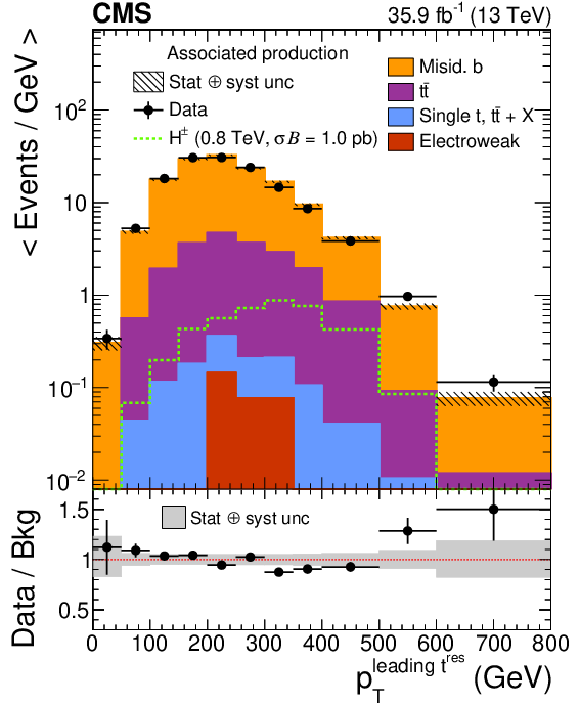
png pdf |
Figure 3-b:
The efficiency of the $ {\mathrm{t} ^\text {res}} $ selection in simulated ${\mathrm{t} {}\mathrm{\bar{t}}}$ pairs and the misidentification rate for QCD multijet background, as a function of top quark or top quark candidate ${p_{\mathrm {T}}}$, respectively (left). The ${p_{\mathrm {T}}}$ distribution of the leading ${\mathrm{t} ^\text {res}}$ (right) for the signal model and background with normalization fixed to the SM expectation. The dominant background containing misidentified b-jets is primarily composed of QCD multijet processes. The expectation for a signal with $ {m_{\mathrm{H} ^\pm}} = $ 0.8 TeV is also shown. |
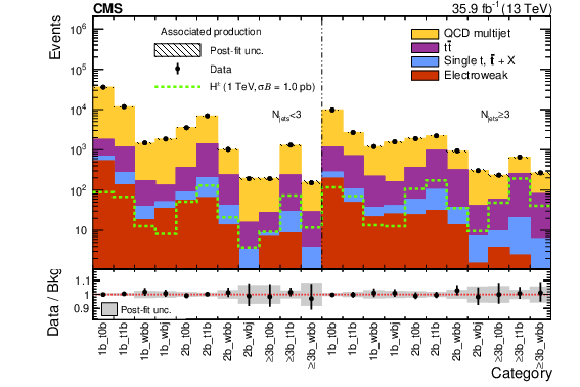
png pdf |
Figure 4:
Expected event yields for the boosted analysis in the mass window as defined in Fig. 2 for a ${\mathrm{\tilde{H}^{\pm_j}}}$ with mass 1 TeV in each of the signal categories used with the associated production model. The 11 categories on the left contain low jet multiplicity ($N_{\text {jets}} < $ 3), while categories on the right have high jet multiplicity ($N_{\text {jets}} \ge $ 3). The yields observed in data (black markers) are overlaid. The dashed lines represent the yields for an ${\mathrm{\tilde{H}^{\pm_j}}}$ with a mass of 1 TeV and $\sigma \mathcal {B}=$ 1 pb for associated production. The background distributions result from the global fit described in the text for the background-only hypothesis. Similar categories are fitted for the $s$-channel production. |
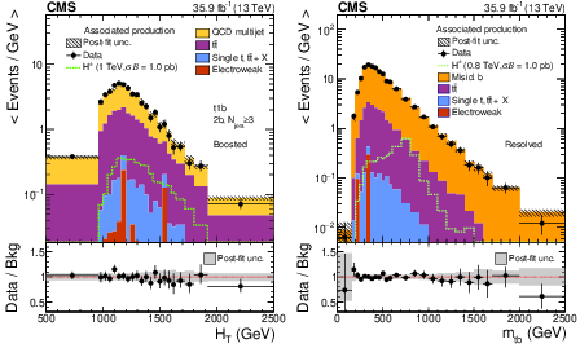
png pdf |
Figure 5:
Variables used in the limit extraction. The ${H_{\mathrm {T}}}$ distribution for the boosted analysis and for the category t1b, 2b, $N_{\text {jets}} \geq $ 3 (left), for the associated production channels, with the expected signal shown for $ {m_{\mathrm{H} ^\pm}} = $ 1 TeV. The invariant mass of the ${\mathrm{\tilde{H}^{\pm_j}}}$ candidates for the resolved analysis (right), with the expected signal shown for $ {m_{\mathrm{H} ^\pm}} = $ 0.8 TeV. The background distributions result from the background-only fit discussed in the text. The distributions are binned according to the statistical precision of the samples, leading to wider bins in the tail of the distributions. |

png pdf |
Figure 5-a:
Variables used in the limit extraction. The ${H_{\mathrm {T}}}$ distribution for the boosted analysis and for the category t1b, 2b, $N_{\text {jets}} \geq $ 3 (left), for the associated production channels, with the expected signal shown for $ {m_{\mathrm{H} ^\pm}} = $ 1 TeV. The invariant mass of the ${\mathrm{\tilde{H}^{\pm_j}}}$ candidates for the resolved analysis (right), with the expected signal shown for $ {m_{\mathrm{H} ^\pm}} = $ 0.8 TeV. The background distributions result from the background-only fit discussed in the text. The distributions are binned according to the statistical precision of the samples, leading to wider bins in the tail of the distributions. |
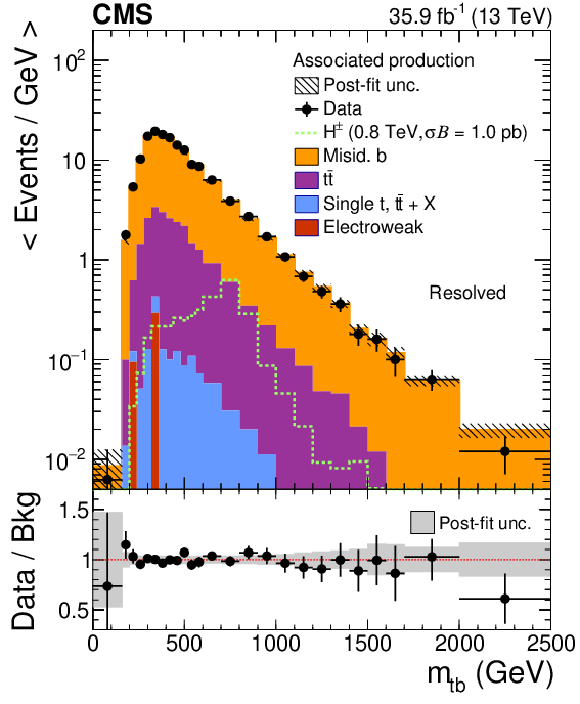
png pdf |
Figure 5-b:
Variables used in the limit extraction. The ${H_{\mathrm {T}}}$ distribution for the boosted analysis and for the category t1b, 2b, $N_{\text {jets}} \geq $ 3 (left), for the associated production channels, with the expected signal shown for $ {m_{\mathrm{H} ^\pm}} = $ 1 TeV. The invariant mass of the ${\mathrm{\tilde{H}^{\pm_j}}}$ candidates for the resolved analysis (right), with the expected signal shown for $ {m_{\mathrm{H} ^\pm}} = $ 0.8 TeV. The background distributions result from the background-only fit discussed in the text. The distributions are binned according to the statistical precision of the samples, leading to wider bins in the tail of the distributions. |

png pdf |
Figure 6:
Upper limits at 95% CL on the cross section times branching fraction as a function of ${m_{\mathrm{H} ^\pm}}$ for the associated (left) and $s$-channel (right) processes. The observed upper limits are shown by the solid black markers. The median expected limit (dashed line), 68% (inner green band), and 95% (outer yellow band) confidence interval for the expected limits are also shown. For the associated channel limits are calculated from the resolved (boosted) analysis for ${m_{\mathrm{H} ^\pm}}$ points less (greater) than 0.9 TeV. |
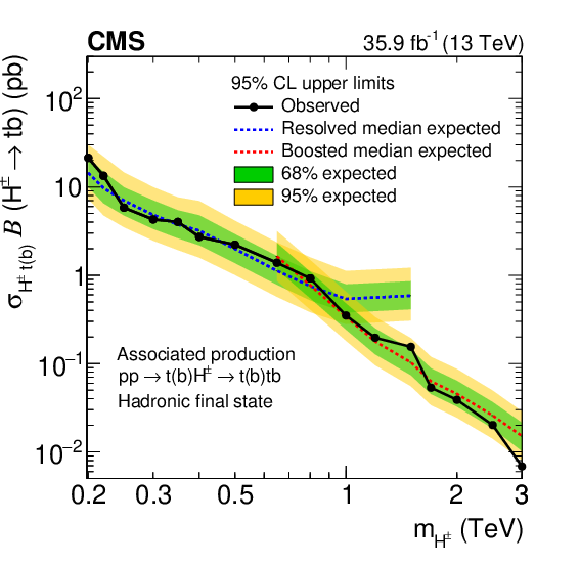
png pdf |
Figure 6-a:
Upper limits at 95% CL on the cross section times branching fraction as a function of ${m_{\mathrm{H} ^\pm}}$ for the associated (left) and $s$-channel (right) processes. The observed upper limits are shown by the solid black markers. The median expected limit (dashed line), 68% (inner green band), and 95% (outer yellow band) confidence interval for the expected limits are also shown. For the associated channel limits are calculated from the resolved (boosted) analysis for ${m_{\mathrm{H} ^\pm}}$ points less (greater) than 0.9 TeV. |

png pdf |
Figure 6-b:
Upper limits at 95% CL on the cross section times branching fraction as a function of ${m_{\mathrm{H} ^\pm}}$ for the associated (left) and $s$-channel (right) processes. The observed upper limits are shown by the solid black markers. The median expected limit (dashed line), 68% (inner green band), and 95% (outer yellow band) confidence interval for the expected limits are also shown. For the associated channel limits are calculated from the resolved (boosted) analysis for ${m_{\mathrm{H} ^\pm}}$ points less (greater) than 0.9 TeV. |

png pdf |
Figure 7:
Excluded parameter space region in the hMSSM scenario (left) and ${M_\mathrm {\mathrm{h}}^\mathrm {125}(\tilde{\chi})}$ (right). The observed upper limits are shown by the solid black markers. The median expected limit (dashed line), 68% (inner green band), and 95% (outer yellow band) confidence interval for the expected limits are also shown. The region below the red line is excluded assuming that the observed neutral Higgs boson is the light CP-even 2HDM Higgs boson with a mass of 125 $\pm$ 3 GeV, where the uncertainty is the theoretical uncertainty in the mass calculation. |
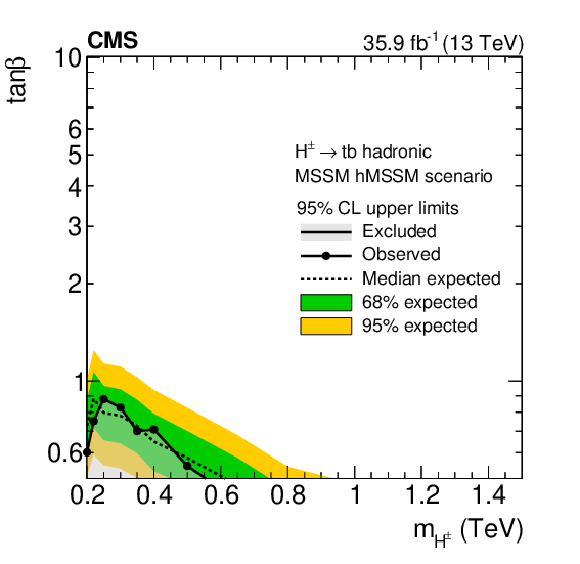
png pdf |
Figure 7-a:
Excluded parameter space region in the hMSSM scenario (left) and ${M_\mathrm {\mathrm{h}}^\mathrm {125}(\tilde{\chi})}$ (right). The observed upper limits are shown by the solid black markers. The median expected limit (dashed line), 68% (inner green band), and 95% (outer yellow band) confidence interval for the expected limits are also shown. The region below the red line is excluded assuming that the observed neutral Higgs boson is the light CP-even 2HDM Higgs boson with a mass of 125 $\pm$ 3 GeV, where the uncertainty is the theoretical uncertainty in the mass calculation. |
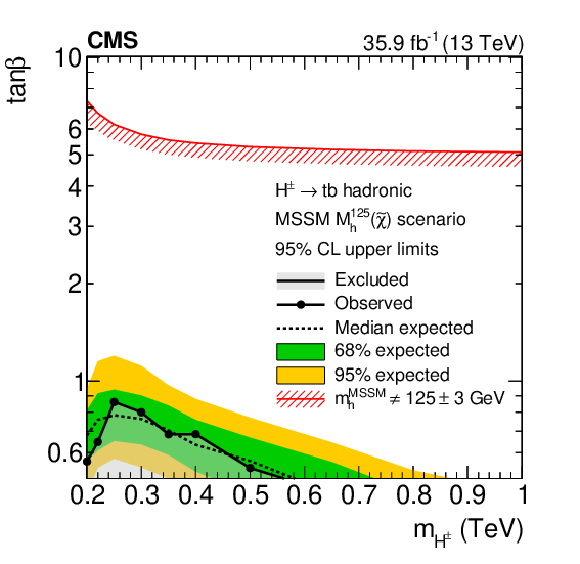
png pdf |
Figure 7-b:
Excluded parameter space region in the hMSSM scenario (left) and ${M_\mathrm {\mathrm{h}}^\mathrm {125}(\tilde{\chi})}$ (right). The observed upper limits are shown by the solid black markers. The median expected limit (dashed line), 68% (inner green band), and 95% (outer yellow band) confidence interval for the expected limits are also shown. The region below the red line is excluded assuming that the observed neutral Higgs boson is the light CP-even 2HDM Higgs boson with a mass of 125 $\pm$ 3 GeV, where the uncertainty is the theoretical uncertainty in the mass calculation. |
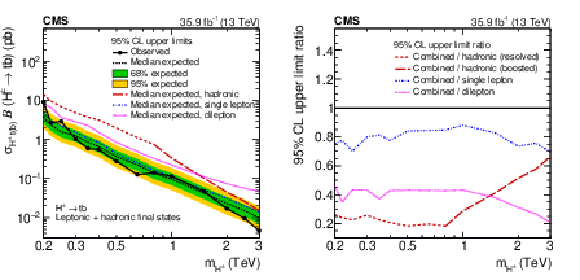
png pdf |
Figure 8:
Upper limits at 95% CL on the cross section times branching fraction as function of ${m_{\mathrm{H} ^\pm}}$ for the process $ {\sigma _{\mathrm{H} ^\pm \mathrm{t} (\mathrm{b})}} {\mathcal {B}(\mathrm{H} ^\pm \to \mathrm{t} \mathrm{b})}$. The median expected limit (dashed line), 68% (inner green band), and 95% (outer yellow band) confidence interval expected limits are also shown (left). The relative expected contribution of each channel to the overall combination is shown (right). The black solid line corresponds to the combined expected limits while the dashed, dotted and dash-dotted represent the contributing channels. |

png pdf |
Figure 8-a:
Upper limits at 95% CL on the cross section times branching fraction as function of ${m_{\mathrm{H} ^\pm}}$ for the process $ {\sigma _{\mathrm{H} ^\pm \mathrm{t} (\mathrm{b})}} {\mathcal {B}(\mathrm{H} ^\pm \to \mathrm{t} \mathrm{b})}$. The median expected limit (dashed line), 68% (inner green band), and 95% (outer yellow band) confidence interval expected limits are also shown (left). The relative expected contribution of each channel to the overall combination is shown (right). The black solid line corresponds to the combined expected limits while the dashed, dotted and dash-dotted represent the contributing channels. |

png pdf |
Figure 8-b:
Upper limits at 95% CL on the cross section times branching fraction as function of ${m_{\mathrm{H} ^\pm}}$ for the process $ {\sigma _{\mathrm{H} ^\pm \mathrm{t} (\mathrm{b})}} {\mathcal {B}(\mathrm{H} ^\pm \to \mathrm{t} \mathrm{b})}$. The median expected limit (dashed line), 68% (inner green band), and 95% (outer yellow band) confidence interval expected limits are also shown (left). The relative expected contribution of each channel to the overall combination is shown (right). The black solid line corresponds to the combined expected limits while the dashed, dotted and dash-dotted represent the contributing channels. |
| Tables | |
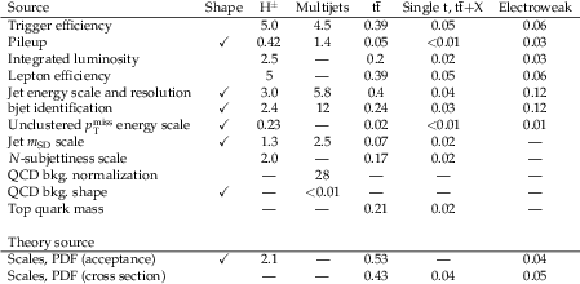
png pdf |
Table 1:
The systematic uncertainties affecting signal and background for the boosted analysis, evaluated after fitting to data, summed over all final states and categories. The numbers are given in percentage and describe the effect of each nuisance parameter on the overall normalization of each event category. Nuisance parameters with a check mark also affect the shape of the ${H_{\mathrm {T}}}$ spectrum. Sources that do not apply in a given process are marked with dashes. For the $\mathrm{H} ^{\pm}$ signal, the values for $ {m_{\mathrm{H} ^\pm}} = $ 1 TeV and for associated production are shown. |

png pdf |
Table 2:
The systematic uncertainties in the backgrounds and the signal for the resolved analysis, evaluated after fitting to data, summed over all final states and categories. The numbers are given in percentage and describe the effect of each nuisance parameter on the overall normalization of each event category. Nuisance parameters with a check mark also affect the shape of the $\mathrm{H} ^{\pm}$ candidate mass spectrum. Sources that do not apply in a given process are marked with dashes. For the $\mathrm{H} ^{\pm}$ signal, the values for $ {m_{\mathrm{H} ^\pm}} = $ 0.5 TeV are shown. |
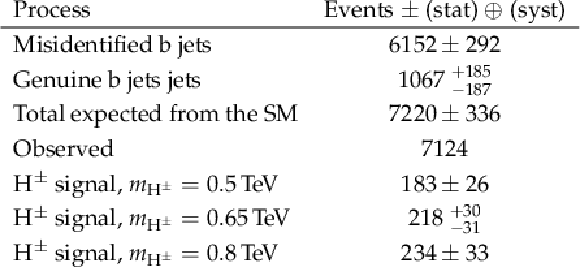
png pdf |
Table 3:
The numbers of expected and observed events for the resolved analysis after all selections. For background processes, the event yields and their corresponding uncertainties are prior to the background-only fit to the data. For the $\mathrm{H} ^{\pm}$ mass hypotheses of 0.50, 0.65, and 0.80 TeV, the signal yields are normalized to a $\sigma \mathcal {B}=$ 1 pb and the total systematic uncertainties prior to the fit are shown. |
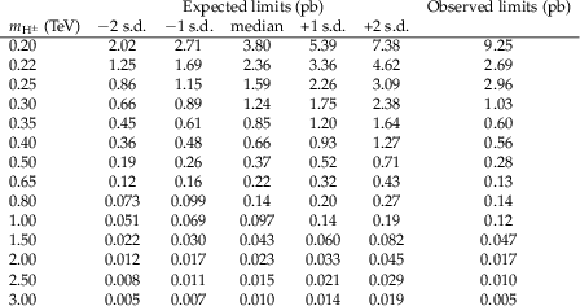
png pdf |
Table 4:
The upper limit at 95% CL on the $ {\sigma _{\mathrm{H} ^\pm \mathrm{t} (\mathrm{b})}} {\mathcal {B}(\mathrm{H} ^\pm \to \mathrm{t} \mathrm{b})}$ with the combined all-jet, single-lepton, and dilepton final states. |
| Summary |
| Results are presented from a search for charged Higgs bosons (${\mathrm{\tilde{H}^{\pm_j}}}$) that decay to a top and a bottom quark in the all-jet final state. The search considers two distinct event topologies. The ${\mathrm{\tilde{H}^{\pm_j}}}$ is reconstructed from a b-tagged jet in combination with a top quark candidate, either resolved as two jets from $\mathrm{q\bar{q}'}$ decays of a W boson and an additional b-tagged jet, or, for highly boosted decay products, reconstructed as a single top-flavored jet or a W jet paired with an additional b-tagged jet. The analysis uses data collected with the CMS detector in 2016 at a center-of-mass energy of $\sqrt{s} =$ 13 TeV, corresponding to an integrated luminosity of 35.9 fb$^{-1}$. No significant deviation is observed above the expected standard model background. Model-independent upper limits at 95% confidence level are set on the product of the ${\mathrm{\tilde{H}^{\pm_j}}}$ production cross section and branching fraction. For production in association with a top quark, limits of 21.3 to 0.007 pb are set for ${\mathrm{\tilde{H}^{\pm_j}}}$ masses in the range 0.2 to 3 TeV. Combining these results with data from a search in leptonic final states of W bosons sets improved limits of 9.25 to 0.005 pb. The complementary $s$-channel production of an ${\mathrm{\tilde{H}^{\pm_j}}}$ is investigated in the mass range 0.8 to 3 TeV and the corresponding upper limits are set at 4.5 to 0.023 pb. Exclusion regions are also presented in the parameter space of the minimal supersymmetric standard model hMSSM and ${M_\mathrm{\mathrm{h}}^\mathrm{125}(\tilde{\chi})}$ benchmark scenarios. |
| References | ||||
| 1 | ATLAS Collaboration | Observation of a new particle in the search for the standard model Higgs boson with the ATLAS detector at the LHC | PLB 716 (2012) 1 | 1207.7214 |
| 2 | CMS Collaboration | Observation of a new boson at a mass of 125 GeV with the CMS experiment at the LHC | PLB 716 (2012) 30 | CMS-HIG-12-028 1207.7235 |
| 3 | CMS Collaboration | Observation of a new boson with mass near 125 GeV in pp collisions at $ \sqrt{s} = $ 7 and 8 TeV | JHEP 06 (2013) 081 | CMS-HIG-12-036 1303.4571 |
| 4 | ATLAS and CMS Collaborations | Combined measurement of the Higgs boson mass in pp collisions at $ \sqrt{s} = $ 7 and 8 TeV with the ATLAS and CMS experiments | PRL 114 (2015) 191803 | 1503.07589 |
| 5 | CMS Collaboration | Measurements of properties of the Higgs boson decaying into the four-lepton final state in pp collisions at $ \sqrt{s} = $ 13 TeV | JHEP 11 (2017) 047 | CMS-HIG-16-041 1706.09936 |
| 6 | CMS Collaboration | Constraints on the spin-parity and anomalous HVV couplings of the Higgs boson in proton collisions at 7 and 8 TeV | PRD 92 (2015) 012004 | CMS-HIG-14-018 1411.3441 |
| 7 | ATLAS Collaboration | Study of the spin and parity of the Higgs boson in diboson decays with the ATLAS detector | EPJC 75 (2015) 476 | 1506.05669 |
| 8 | ATLAS and CMS Collaborations | Measurements of the Higgs boson production and decay rates and constraints on its couplings from a combined ATLAS and CMS analysis of the LHC pp collision data at $ \sqrt{s} = $ 7 and 8 TeV | JHEP 08 (2016) 045 | 1606.02266 |
| 9 | J. F. Gunion and H. E. Haber | The CP conserving two Higgs doublet model: the approach to the decoupling limit | PRD 67 (2003) 075019 | hep-ph/0207010 |
| 10 | A. G. Akeroyd et al. | Prospects for charged Higgs searches at the LHC | EPJC 77 (2017) 276 | 1607.01320 |
| 11 | G. C. Branco et al. | Theory and phenomenology of two-Higgs-doublet models | PR 516 (2012) 1 | 1106.0034 |
| 12 | N. Craig and S. Thomas | Exclusive signals of an extended Higgs sector | JHEP 11 (2012) 083 | 1207.4835 |
| 13 | A. Djouadi | The anatomy of electro-weak symmetry breaking. II: the Higgs bosons in the minimal supersymmetric model | PR 459 (2008) 1 | hep-ph/0503173 |
| 14 | M. Carena et al. | MSSM Higgs boson searches at the LHC: benchmark scenarios after the discovery of a Higgs-like particle | EPJC 73 (2013) 2552 | 1302.7033 |
| 15 | M. Carena, I. Low, N. R. Shah, and C. E. M. Wagner | Impersonating the standard model Higgs boson: alignment without decoupling | JHEP 04 (2014) 015 | 1310.2248 |
| 16 | LHC Higgs Cross Section Working Group | Handbook of LHC Higgs cross sections: 4. deciphering the nature of the Higgs sector | CERN (2016) | 1610.07922 |
| 17 | R. Harlander, M. Kramer, and M. Schumacher | Bottom-quark associated Higgs-boson production: reconciling the four- and five-flavour scheme approach | 1112.3478 | |
| 18 | CMS Collaboration | Search for a charged Higgs boson in pp collisions at $ \sqrt{s} = $ 8 TeV | JHEP 11 (2015) 018 | CMS-HIG-14-023 1508.07774 |
| 19 | ATLAS Collaboration | Search for charged Higgs bosons in the $ H^{\pm} \rightarrow tb $ decay channel in $ pp $ collisions at $ \sqrt{s} = $ 8 TeV using the ATLAS detector | JHEP 03 (2016) 127 | 1512.03704 |
| 20 | ATLAS Collaboration | Search for charged Higgs bosons decaying into top and bottom quarks at $ \sqrt{s} = $ 13 TeV with the ATLAS detector | JHEP 11 (2018) 085 | 1808.03599 |
| 21 | CMS Collaboration | Search for a charged Higgs boson decaying into top and bottom quarks in proton-proton collisions at $ \sqrt{s}= $ 13 TeV in events with electrons or muons | Acc. by JHEP | CMS-HIG-18-004 1908.09206 |
| 22 | CMS Collaboration | Search for a light charged Higgs boson decaying to $ \mathrm{c}\overline{\mathrm{s}} $ in pp collisions at $ \sqrt{s} = $ 8 TeV | JHEP 12 (2015) 178 | CMS-HIG-13-035 1510.04252 |
| 23 | CMS Collaboration | Search for a charged Higgs boson decaying to charm and bottom quarks in proton-proton collisions at $ \sqrt{s} = $ 8 TeV | JHEP 11 (2018) 115 | CMS-HIG-16-030 1808.06575 |
| 24 | ATLAS Collaboration | Search for charged Higgs bosons decaying via $ H^{\pm} \rightarrow \tau^{\pm}\nu $ in fully hadronic final states using $ pp $ collision data at $ \sqrt{s} = $ 8 TeV with the ATLAS detector | JHEP 03 (2015) 088 | 1412.6663 |
| 25 | ATLAS Collaboration | Search for charged Higgs bosons decaying via $ H^{\pm} \to \tau^{\pm}\nu_{\tau} $ in the $ \tau $+jets and $ \tau $+lepton final states with 36 fb$ ^{-1} $ of $ pp $ collision data recorded at $ \sqrt{s} = $ 13 TeV with the ATLAS experiment | JHEP 09 (2018) 139 | 1807.07915 |
| 26 | CMS Collaboration | Search for charged Higgs bosons in the H$ ^{\pm} \to \tau^{\pm}\nu_\tau $ decay channel in proton-proton collisions at $ \sqrt{s} = $ 13 TeV | JHEP 07 (2019) 142 | CMS-HIG-18-014 1903.04560 |
| 27 | BaBar and Belle Collaboration | The physics of the B factories | EPJC 74 (2014) 3026 | 1406.6311 |
| 28 | Belle-II Collaboration | The Belle II physics book | 1808.10567 | |
| 29 | CMS Collaboration | Search for beyond the standard model Higgs bosons decaying into a $ \mathrm{b\overline{b}} $ pair in pp collisions at $ \sqrt{s} = $ 13 TeV | JHEP 08 (2018) 113 | CMS-HIG-16-018 1805.12191 |
| 30 | CMS Collaboration | Search for additional neutral MSSM Higgs bosons in the $ \tau\tau $ final state in proton-proton collisions at $ \sqrt{s}= $ 13 TeV | JHEP 09 (2018) 007 | CMS-HIG-17-020 1803.06553 |
| 31 | ATLAS Collaboration | Search for additional heavy neutral Higgs and gauge bosons in the ditau final state produced in 36 fb$ ^{-1} $ of pp collisions at $ \sqrt{s} = $ 13 TeV with the ATLAS detector | JHEP 01 (2018) 055 | 1709.07242 |
| 32 | ATLAS Collaboration | Search for heavy Higgs bosons A/H decaying to a top quark pair in $ pp $ collisions at $ \sqrt{s} = $ 8 TeV with the ATLAS detector | PRL 119 (2017) 191803 | 1707.06025 |
| 33 | CMS Collaboration | Search for physics beyond the standard model in events with two leptons of same sign, missing transverse momentum, and jets in proton-proton collisions at $ \sqrt{s} = $ 13 TeV | EPJC 77 (2017) 578 | CMS-SUS-16-035 1704.07323 |
| 34 | CMS Collaboration | Search for heavy Higgs bosons decaying to a top quark pair in proton-proton collisions at $ \sqrt{s} = $ 13 TeV | Sub. to JHEP | CMS-HIG-17-027 1908.01115 |
| 35 | H. Georgi and M. Machacek | Doubly charged Higgs bosons | NPB 262 (1985) 463 | |
| 36 | CMS Collaboration | Search for charged Higgs bosons produced via vector boson fusion and decaying into a pair of W and Z bosons using pp collisions at $ \sqrt{s} = $ 13 TeV | PRL 119 (2017) 141802 | CMS-HIG-16-027 1705.02942 |
| 37 | CMS Collaboration | Observation of electroweak production of same-sign W boson pairs in the two jet and two same-sign lepton final state in proton-proton collisions at $ \sqrt{s} = $ 13 TeV | PRL 120 (2018) 081801 | CMS-SMP-17-004 1709.05822 |
| 38 | E. Malkawi, T. M. P. Tait, and C. P. Yuan | A model of strong flavor dynamics for the top quark | PLB 385 (1996) 304 | hep-ph/9603349 |
| 39 | CMS Collaboration | Search for heavy resonances decaying to a top quark and a bottom quark in the lepton+jets final state in proton-proton collisions at 13 TeV | PLB 777 (2018) 39 | CMS-B2G-17-010 1708.08539 |
| 40 | CMS Collaboration | The CMS trigger system | JINST 12 (2017) P01020 | CMS-TRG-12-001 1609.02366 |
| 41 | CMS Collaboration | The CMS experiment at the CERN LHC | JINST 3 (2008) S08004 | CMS-00-001 |
| 42 | J. Alwall et al. | The automated computation of tree-level and next-to-leading order differential cross sections, and their matching to parton shower simulations | JHEP 07 (2014) 079 | 1405.0301 |
| 43 | CompHEP Collaboration | Comphep 4.4: Automatic computations from lagrangians to events | NIMA 534 (2004) 250 | hep-ph/0403113 |
| 44 | S. Heinemeyer, W. Hollik, and G. Weiglein | Feynhiggs: a program for the calculation of the masses of the neutral CP even Higgs bosons in the MSSM | CPC 124 (2000) 76 | hep-ph/9812320 |
| 45 | E. L. Berger, T. Han, J. Jiang, and T. Plehn | Associated production of a top quark and a charged Higgs boson | PRD 71 (2005) 115012 | hep-ph/0312286 |
| 46 | M. Flechl et al. | Improved cross-section predictions for heavy charged Higgs boson production at the LHC | PRD 91 (2015) 075015 | 1409.5615 |
| 47 | C. Degrande, M. Ubiali, M. Wiesemann, and M. Zaro | Heavy charged Higgs boson production at the LHC | JHEP 10 (2015) 145 | 1507.02549 |
| 48 | S. Dittmaier, M. Kramer, M. Spira, and M. Walser | Charged Higgs boson production at the LHC: NLO supersymmetric QCD corrections | PRD 83 (2011) 055005 | 0906.2648 |
| 49 | A. Djouadi, J. Kalinowski, and M. Spira | HDECAY: a program for Higgs boson decays in the standard model and its supersymmetric extension | CPC 108 (1998) 56 | hep-ph/9704448 |
| 50 | P. Nason | A new method for combining NLO QCD with shower Monte Carlo algorithms | JHEP 11 (2004) 040 | hep-ph/0409146 |
| 51 | S. Frixione, P. Nason, and C. Oleari | Matching NLO QCD computations with parton shower simulations: the POWHEG method | JHEP 11 (2007) 070 | 0709.2092 |
| 52 | S. Alioli, P. Nason, C. Oleari, and E. Re | A general framework for implementing NLO calculations in shower Monte Carlo programs: the POWHEG BOX | JHEP 06 (2010) 043 | 1002.2581 |
| 53 | S. Frixione, P. Nason, and G. Ridolfi | A positive-weight next-to-leading-order Monte Carlo for heavy flavour hadroproduction | JHEP 09 (2007) 126 | 0707.3088 |
| 54 | R. Frederix, E. Re, and P. Torrielli | Single-top $ t $-channel hadroproduction in the four-flavour scheme with POWHEG and aMC@NLO | JHEP 09 (2012) 130 | 1207.5391 |
| 55 | P. Artoisenet, R. Frederix, O. Mattelaer, and R. Rietkerk | Automatic spin-entangled decays of heavy resonances in Monte Carlo simulations | JHEP 03 (2013) 015 | 1212.3460 |
| 56 | E. Re | Single-top W$ t $-channel production matched with parton showers using the powheg method | EPJC 71 (2011) 1547 | 1009.2450 |
| 57 | H. B. Hartanto, B. Jager, L. Reina, and D. Wackeroth | Higgs boson production in association with top quarks in the POWHEG BOX | PRD 91 (2015) 094003 | 1501.04498 |
| 58 | N. Kidonakis | Differential and total cross sections for top pair and single top production | in Proceedings, 20th International Workshop on Deep-Inelastic Scattering and Related Subjects (DIS 2012): Bonn, Germany, March 26-30, 2012, p. 831 2012 | 1205.3453 |
| 59 | M. Cacciari et al. | Top-pair production at hadron colliders with next-to-next-to-leading logarithmic soft-gluon resummation | PLB 710 (2012) 612 | 1111.5869 |
| 60 | P. Barnreuther, M. Czakon, and A. Mitov | Percent level precision physics at the tevatron: First genuine NNLO QCD corrections to $ q \bar{q} \to t \bar{t} + x $ | PRL 109 (2012) 132001 | 1204.5201 |
| 61 | M. Czakon and A. Mitov | NNLO corrections to top-pair production at hadron colliders: the all-fermionic scattering channels | JHEP 12 (2012) 054 | 1207.0236 |
| 62 | M. Czakon and A. Mitov | NNLO corrections to top pair production at hadron colliders: the quark-gluon reaction | JHEP 01 (2013) 080 | 1210.6832 |
| 63 | M. Beneke, P. Falgari, S. Klein, and C. Schwinn | Hadronic top-quark pair production with NNLL threshold resummation | NPB 855 (2012) 695 | 1109.1536 |
| 64 | M. Czakon, P. Fiedler, and A. Mitov | Total top-quark pair-production cross section at hadron colliders through $ {O}(\frac{4}{S}) $ | PRL 110 (2013) 252004 | 1303.6254 |
| 65 | M. Czakon and A. Mitov | Top++: A program for the calculation of the top-pair cross-section at hadron colliders | CPC 185 (2014) 2930 | 1112.5675 |
| 66 | M. Aliev et al. | HATHOR: Hadronic top and heavy quarks cross section calculator | CPC 182 (2011) 1034 | 1007.1327 |
| 67 | P. Kant et al. | HATHOR for single top-quark production: Updated predictions and uncertainty estimates for single top-quark production in hadronic collisions | CPC 191 (2015) 74 | 1406.4403 |
| 68 | F. Maltoni, D. Pagani, and I. Tsinikos | Associated production of a top-quark pair with vector bosons at NLO in QCD: impact on $ \mathrm{t}\overline{\mathrm{t}}\mathrm{H} $ searches at the LHC | JHEP 02 (2016) 113 | 1507.05640 |
| 69 | J. M. Campbell, R. K. Ellis, and C. Williams | Vector boson pair production at the LHC | JHEP 07 (2011) 018 | 1105.0020 |
| 70 | N. Kidonakis | Two-loop soft anomalous dimensions for single top quark associated production with a W$ ^- $ or H$ ^- $ | PRD 82 (2010) 054018 | 1005.4451 |
| 71 | NNPDF Collaboration | Unbiased global determination of parton distributions and their uncertainties at NNLO and at LO | NPB 855 (2012) 153 | 1107.2652 |
| 72 | T. Sjostrand et al. | An introduction to PYTHIA 8.2 | CPC 191 (2015) 159 | 1410.3012 |
| 73 | CMS Collaboration | Study of the underlying event in top quark pair production in $ \mathrm {p}\mathrm {p} $ collisions at 13 $ \text {Te}\text {V} $ | EPJC 79 (2019) 123 | CMS-TOP-17-015 1807.02810 |
| 74 | P. Skands, S. Carrazza, and J. Rojo | Tuning PYTHIA 8.1: the Monash 2013 tune | EPJC 74 (2014) 3024 | 1404.5630 |
| 75 | CMS Collaboration | Event generator tunes obtained from underlying event and multiparton scattering measurements | EPJC 76 (2016) 155 | CMS-GEN-14-001 1512.00815 |
| 76 | GEANT4 Collaboration | GEANT4 --- a simulation toolkit | NIMA 506 (2003) 250 | |
| 77 | CMS Collaboration | Measurement of the inelastic proton-proton cross section at $ \sqrt{s}= $ 13 TeV | JHEP 07 (2018) 161 | CMS-FSQ-15-005 1802.02613 |
| 78 | CMS Collaboration | Particle-flow reconstruction and global event description with the CMS detector | JINST 12 (2017) P10003 | CMS-PRF-14-001 1706.04965 |
| 79 | CMS Collaboration | Performance of electron reconstruction and selection with the CMS detector in proton-proton collisions at $ \sqrt{s} = $ 8 TeV | JINST 10 (2015) P06005 | CMS-EGM-13-001 1502.02701 |
| 80 | CMS Collaboration | Performance of the CMS muon detector and muon reconstruction with proton-proton collisions at $ \sqrt{s} = $ 13 TeV | JINST 13 (2018) P06015 | CMS-MUO-16-001 1804.04528 |
| 81 | CMS Collaboration | Performance of reconstruction and identification of $ \tau $ leptons decaying to hadrons and $ \nu_\tau $ in pp collisions at $ \sqrt{s}= $ 13 TeV | JINST 13 (2018) P10005 | CMS-TAU-16-003 1809.02816 |
| 82 | CMS Collaboration | Reconstruction and identification of $ \tau $ lepton decays to hadrons and $ \nu_\tau $ at CMS | JINST 11 (2016) P01019 | CMS-TAU-14-001 1510.07488 |
| 83 | M. Cacciari, G. P. Salam, and G. Soyez | The anti-$ {k_{\mathrm{T}}} $ jet clustering algorithm | JHEP 04 (2008) 063 | 0802.1189 |
| 84 | M. Cacciari, G. P. Salam, and G. Soyez | FastJet user manual | EPJC 72 (2012) 1896 | 1111.6097 |
| 85 | CMS Collaboration | Pileup mitigation at CMS in 13 TeV data | CMS-PAS-JME-18-001 | CMS-PAS-JME-18-001 |
| 86 | CMS Collaboration | Jet energy scale and resolution in the CMS experiment in pp collisions at 8 TeV | JINST 12 (2017) P02014 | CMS-JME-13-004 1607.03663 |
| 87 | CMS Collaboration | Identification of heavy-flavour jets with the CMS detector in pp collisions at 13 TeV | JINST 13 (2018) P05011 | CMS-BTV-16-002 1712.07158 |
| 88 | CMS Collaboration | Performance of missing transverse momentum reconstruction in proton-proton collisions at $ \sqrt{s} = $ 13 TeV using the CMS detector | JINST 14 (2019) P07004 | CMS-JME-17-001 1903.06078 |
| 89 | D. Krohn, J. Thaler, and L.-T. Wang | Jet trimming | JHEP 02 (2010) 084 | 0912.1342 |
| 90 | A. J. Larkoski, S. Marzani, G. Soyez, and J. Thaler | Soft drop | JHEP 05 (2014) 146 | 1402.2657 |
| 91 | J. Thaler and K. Van Tilburg | Identifying boosted objects with $ {N} $-subjettiness | JHEP 03 (2011) 015 | 1011.2268 |
| 92 | A. Hocker et al. | TMVA --- toolkit for multivariate data analysis | PoS ACAT (2007) 040 | physics/0703039 |
| 93 | CMS Collaboration | Performance of quark/gluon discrimination in 8 TeV pp data | CMS-PAS-JME-13-002 | CMS-PAS-JME-13-002 |
| 94 | CMS Collaboration | Identification of c-quark jets at the CMS experiment | CMS-PAS-BTV-16-001 | CMS-PAS-BTV-16-001 |
| 95 | CMS Collaboration | Search for direct production of supersymmetric partners of the top quark in the all-jets final state in proton-proton collisions at $ \sqrt{s} = $ 13 TeV | JHEP 10 (2017) 005 | CMS-SUS-16-049 1707.03316 |
| 96 | ATLAS Collaboration | Measurement of the inelastic proton-proton cross section at $ \sqrt{s} = $ 13 TeV with the ATLAS detector at the LHC | PRL 117 (2016) 182002 | 1606.02625 |
| 97 | CMS Collaboration | CMS luminosity measurements for the 2016 data taking period | CMS-PAS-LUM-17-001 | CMS-PAS-LUM-17-001 |
| 98 | CMS Collaboration | Jet algorithms performance in 13 TeV data | CMS-PAS-JME-16-003 | CMS-PAS-JME-16-003 |
| 99 | J. Butterworth et al. | PDF4LHC recommendations for LHC Run II | JPG 43 (2016) 023001 | 1510.03865 |
| 100 | R. J. Barlow and C. Beeston | Fitting using finite Monte Carlo samples | CPC 77 (1993) 219 | |
| 101 | J. S. Conway | Incorporating Nuisance Parameters in Likelihoods for Multisource Spectra | in Proceedings, PHYSTAT 2011 Workshop on Statistical Issues Related to Discovery Claims in Search Experiments and Unfolding, CERN,Geneva, Switzerland 17-20 January 2011, p. 115 2011 | 1103.0354 |
| 102 | T. Junk | Confidence level computation for combining searches with small statistics | NIMA 434 (1999) 435 | hep-ex/9902006 |
| 103 | A. L. Read | Presentation of search results: the CLs technique | JPG 28 (2002) 2693 | |
| 104 | G. Cowan, K. Cranmer, E. Gross, and O. Vitells | Asymptotic formulae for likelihood-based tests of new physics | EPJC 71 (2011) 1554 | 1007.1727 |
| 105 | ATLAS and CMS Collaborations | Procedure for the LHC Higgs boson search combination in Summer 2011 | CMS-NOTE-2011-005 | |
| 106 | A. Djouadi and J. Quevillon | The MSSM Higgs sector at a high $ M_{SUSY} $: reopening the low tan$ \beta $ regime and heavy Higgs searches | JHEP 10 (2013) 028 | 1304.1787 |
| 107 | L. Maiani, A. D. Polosa, and V. Riquer | Bounds to the Higgs Sector Masses in Minimal Supersymmetry from LHC Data | PLB 724 (2013) 274 | 1305.2172 |
| 108 | A. Djouadi et al. | The post-Higgs MSSM scenario: Habemus MSSM? | EPJC 73 (2013) 2650 | 1307.5205 |
| 109 | A. Djouadi et al. | Fully covering the MSSM Higgs sector at the LHC | JHEP 06 (2015) 168 | 1502.05653 |
| 110 | E. Bagnaschi et al. | MSSM Higgs Boson Searches at the LHC: Benchmark Scenarios for Run 2 and Beyond | EPJC 79 (2019) 617 | 1808.07542 |

|
Compact Muon Solenoid LHC, CERN |

|

|

|

|

|

|